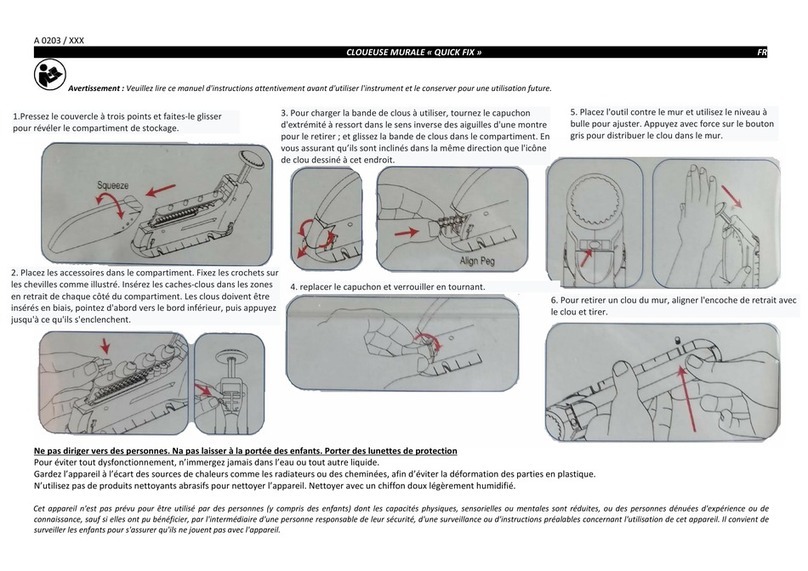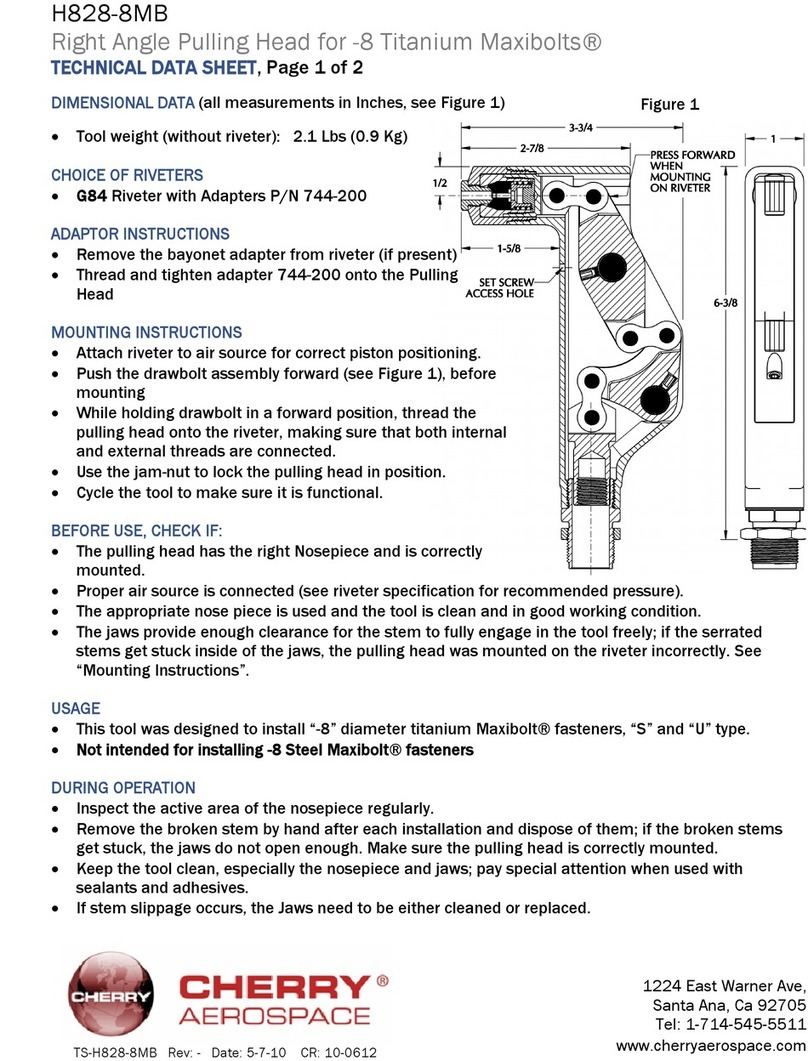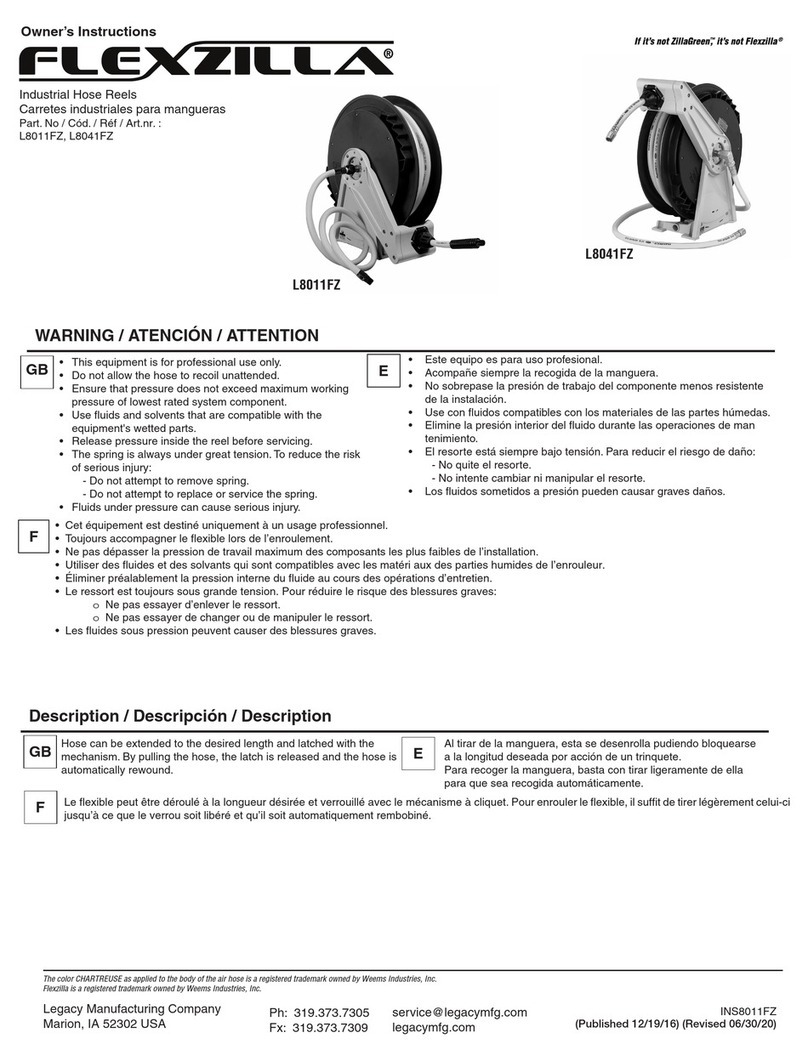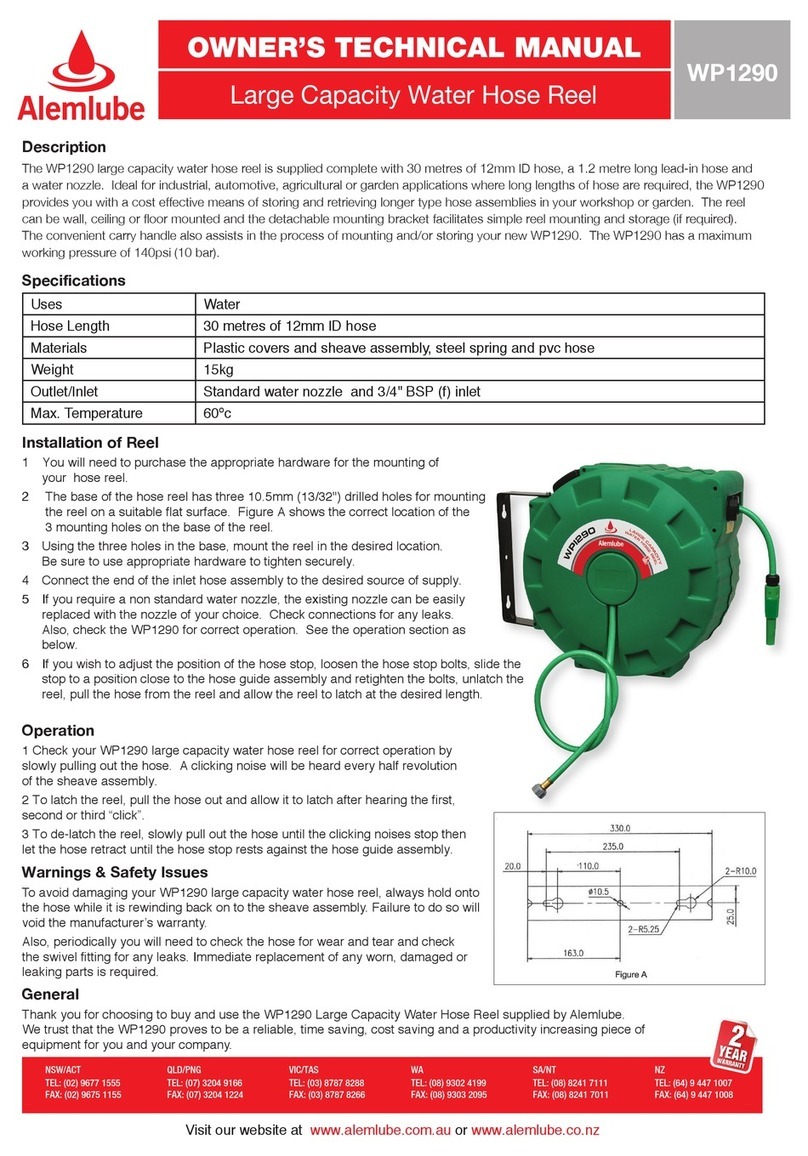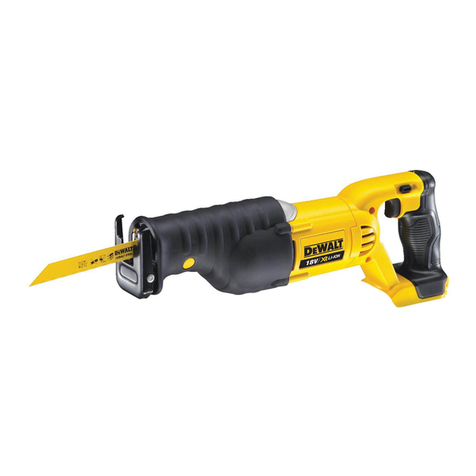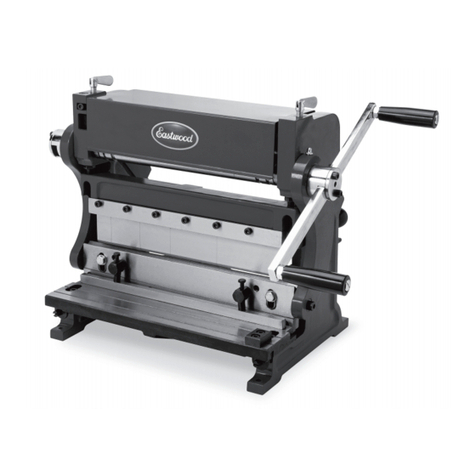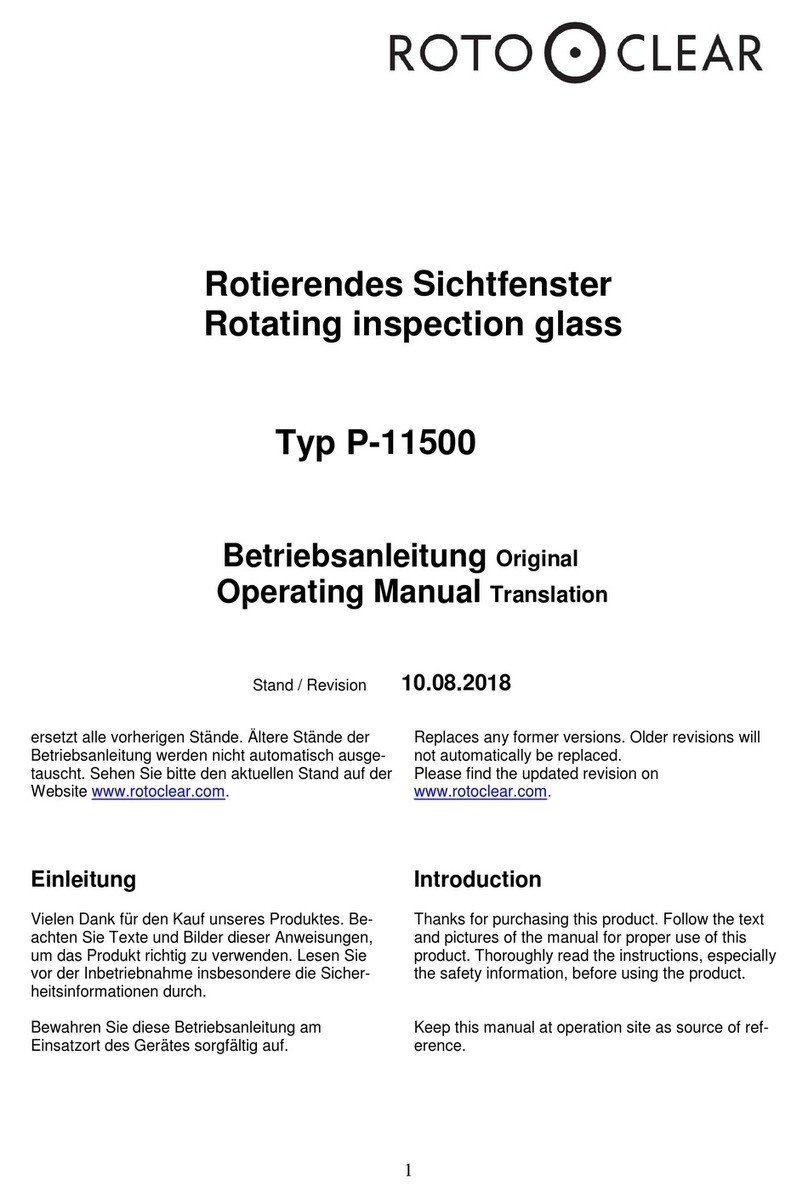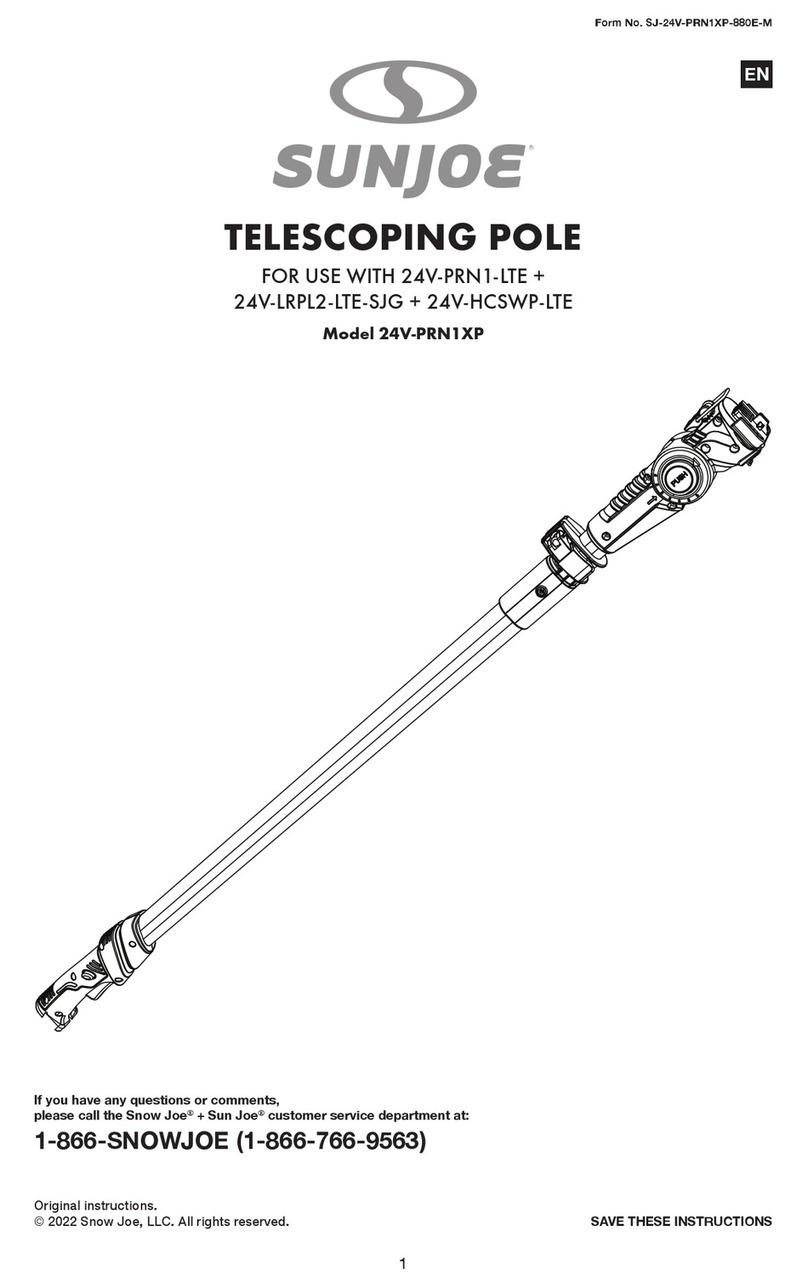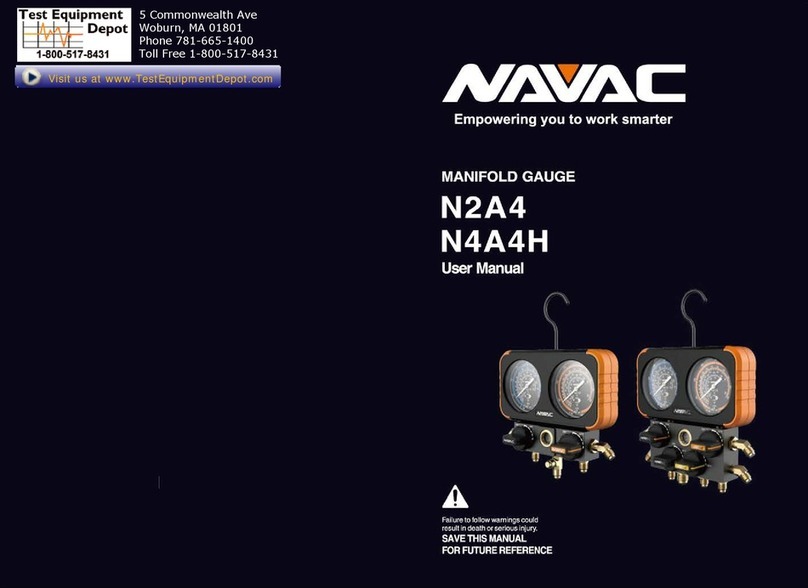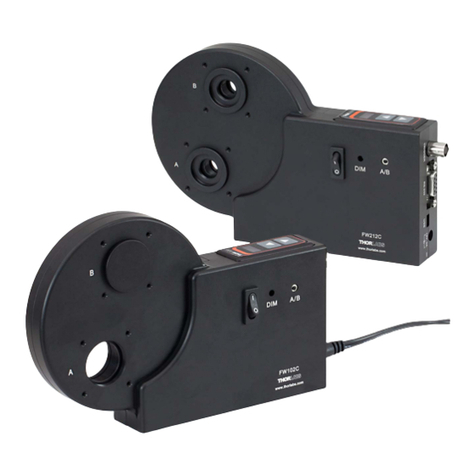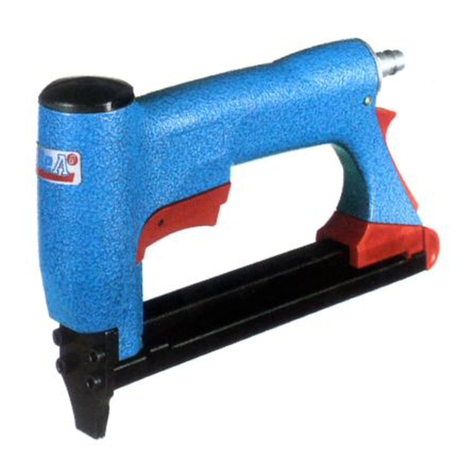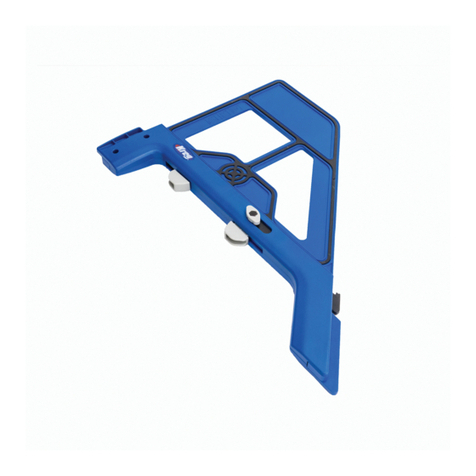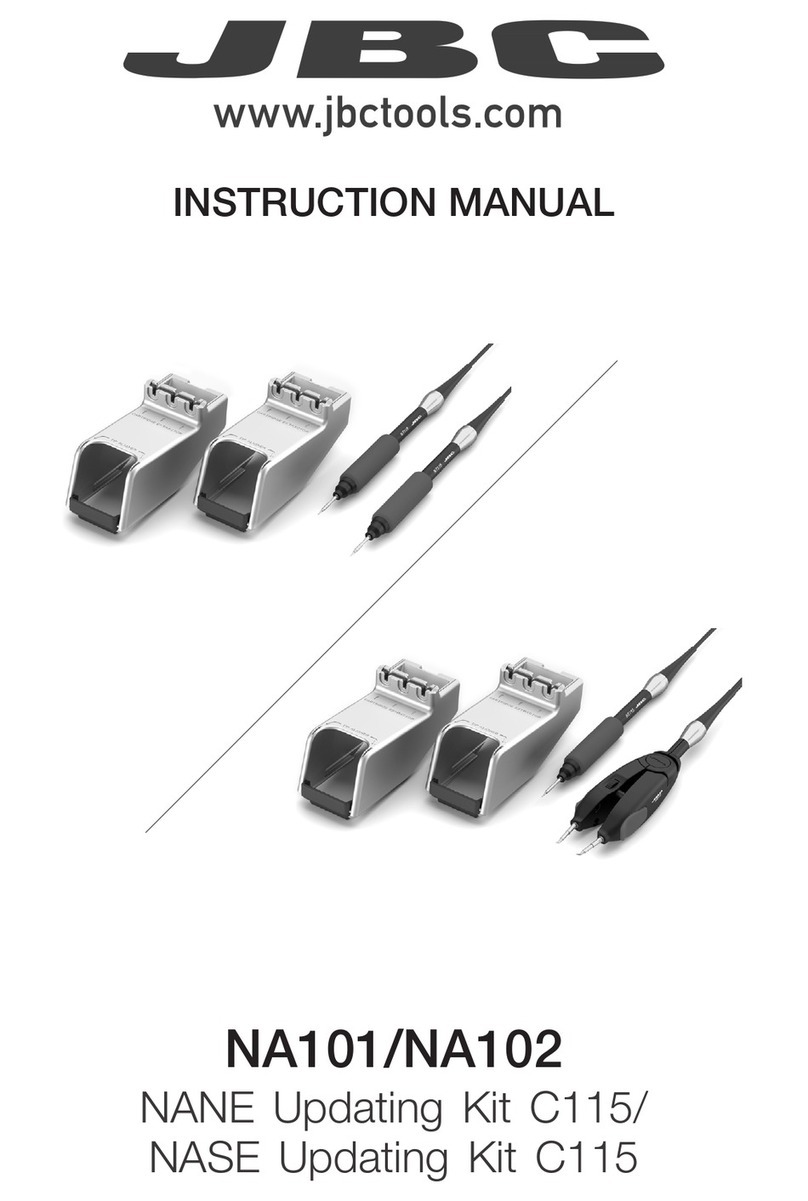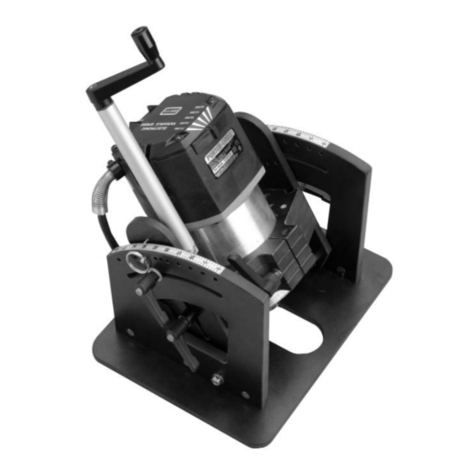NOCRY Jig Set User manual

Jig Set
Instruction Manual
We've worked very hard on making this manual useful, simple, and understandable.
Please read it carefully, and keep it safe for future reference.

1

WHAT'S INSIDE THIS MANUAL
THE ABC'S OF CLAMP AND JIG SET SAFETY 3
Basics of power tool safety 3
Basics of your work area safety 5
Basics of electrical safety 6
Basics of personal safety 7
Basics of servicing your power tools 8
JIG SET KIT PACKAGE CONTENTS 9
HOW TO USE YOUR JIG SET 10
How to create pocket holes 11
How to select the correct screw type 12
How to measure the drill depth 14
How to set the drill depth for drilling pocket holes 14
When using ½ inch and ⅝ material thickness 15
When using ¾ inch material thickness 16
When using 1 inch and above material thickness 17
When using 1 ½ inch and above wood thickness 18
How to conceal pocket holes 18
How to create dowel holes 19
How to set the drill depth for drilling dowel holes 20
How to set the collar stop 22
How to secure the jigset to the workpiece 22
How to join two work pieces 25
TIPS AND TROUBLESHOOTING 26
Drilling tips 26
Reducing wood splitting 26
Gluing workpieces 27
MAINTENANCE 27
JIG SET LIABILITY 28
RESPONSIBLE DISPOSAL 29
WARRANTY 29
HOW TO CONTACT NOCRY 31
2

THE ABC'S OF CLAMP AND JIG SET SAFETY
These are the basic precautions you should take before, during, and after working
with your NoCry clamp and jig set. We've tried to include any safety precautions
that need to be adhered to when using any tools or equipment needed when using
the clamp and jig set kit.
Please read all safety warnings and instructions before
using your clamp and jig
set. They're pretty reasonable, and neglecting them may result in electric shock
and/or serious personal injury. There are other (and much better) ways to get your
adrenaline going.
Save this manual for future reference, review in between uses, and make sure
that anyone who's going to test your new smart charger has read and fully
understood all the information in here as well.
In case this manual disappears into the black hole that all manuals seem to fall
into, you can get a digital version of it at https://nocry.com/pages/instructions,or
by letting us know at [email protected].
Basics of power tool safety
✔
✔
✔
Only use your power tool for its intended use. Would you use a screwdriver
to hammer a nail? Exactly. A suitable tool will do a job a thousand times
better and safer than one that wasn't designed for the task at hand.
Don't force the tool. No one is fond of having to do something they're forced
to do - same goes for your power tools. Do not overload them, and use the
right one for the job.
Do not operate power tools in dusty or explosive areas, such as in the
presence of flammable liquids or gases, for a very simple reason - power
tools may create sparks which could ignite dust or fumes.
3

✔
✔
✔
✔
✔
✔
✔
✔
✔
✔
Your power tools aren’t waterproof or splash proof. Under no
circumstances should you use them in the rain, spray with water, or
immerse in liquid or risk the danger of explosion or electrocution.
Be sure to have a solid grip when drilling long screws, nuts or bolts as
tools can slide off the fastener head and cause you injury.
Remove any adjusting key or wrench before turning your power tool on, if
your power tool requires one. A wrench or a key left attached to a rotating
part of a power tool will ruin your day real fast.
Always wait until the power tool has come to a complete stop before
placing it down, changing the rotational direction, moving onto the next task,
or inserting a drill bit.
Should the tool insert jam, release the trigger switch immediately to stop
the drill and get it sorted. The tool insert jams either when the power tool is
subject to overload or it becomes wedged in the workpiece.
Do not use a malfunctioning power tool. If the switch doesn't turn on
and/or off, it's a pretty clear sign to not use the power tool and to get it
repaired or replaced.
Regularly check screw or drill bits for wear, cracks, or damage before
putting them into the chuck of your power tool.
Keep your cutting tools sharp and clean. Cutting tools that have been
carefully maintained and have sharp cutting edges will jam less and be
easier to control. If you think that more injuries are caused by sharp tools
than dull ones, you'd be surprised.
Disconnect the tool from the power source and/or the battery pack before
making any adjustments, changing accessories, or putting it in storage.
This way, you'll ensure it will not turn on accidentally.
Keep your power tools away from others. Store it away from children and
do not allow anyone unfamiliar with your power tool or this manual, to
operate it.
4

Basics of your work area safety
✔
✔
✔
✔
✔
✔
✔
Keep your working area tidy and well lit. Accidents are much more likely to
happen in dirty, unorganized, or poorly lit workspaces and can be easily
avoided with basic upkeep.
Secure any movable workpiece(s) you're working on. A workpiece secured
with suitable clamps or in a vice is much more likely to be steady and stay in
place than one held by hand.
Ensure your working area is well ventilated. If you smell fumes or feel
other than your usual self, stop working, ventilate the area properly by
opening a window or a door, and seek medical help.
Keep children and bystanders away. Distractions can easily cause you to
lose control, so consider operating your power tools a solo venture. You'll
catch up with everyone later, when you've made progress with your project.
If you absolutely must have children in the working area, ensure that
they're always closely supervised by another, responsible
, adult, and do
not interfere with your work.
Familiarise yourself with your local general rules of occupational health
and safety. The sooner you do that, the sooner you can start using your
clamp and jig set.
Only use your clamp and jig set accessories, tool bits, screws, plugs etc. in
accordance with these instructions. Use of them for anything other than
their intended use could result in a hazardous situation, personal injury AND
voids your warranty (see page 29 for warranty details). In short, we really,
really don’t want you to have an accident. Really.
5

Basics of electrical safety
✔
✔
✔
✔
✔
✔
✔
If you are using an electric drill with a power cord, do not modify plugs,
and make sure that the power tools you use correctly match the power
outlet to reduce your chances on getting an electric shock. Also, adapter
plugs and earthed (grounded) power tools are a really bad combo.
Do not abuse the power cord. The cord isn't the reason you're having a bad
day - and it won't be, if you won't use it for carrying, pulling, or unplugging
the power tool, and will keep it away from heat, oil, sharp edges, and moving
parts.
If the power supply is interrupted (for example, in case of a power failure or
when the mains plug is pulled), immediately set your power tool to its ‘off’
position to prevent uncontrolled restarting.
Find out if there are any utility lines hidden in the work area. Use suitable
detectors or call the local utility company for assistance. It's totally worth it -
only imagine the level of booms and ouchies that coming in contact with
electric lines, damaging a gas line, or penetrating a water line can bring.
When working outside, use an extension cord meant specifically for
outdoors use. It's going to be much more convenient, and will reduce the
risk of an electric shock.
Do not expose your power tools to rain, moisture or wet conditions. Search
“water and electricity don't mix” on YouTube, and you'll see why.
If damp conditions are unavoidable, use a residual current device (RCD)
protected supply.
6

Basics of personal safety
✔
✔
✔
✔
✔
✔
✔
Don't underestimate the power of safety gear. No one has ever felt sorry
about using safety glasses, gloves, dust masks, non skid safety shoes, hard
hats, and/or hearing protection when operating power tools. But there's A
LOT of people who feel sorry they didn't. On that note…
Dress appropriately. Your power tools strongly prefer clothing and
accessories that are tight on your body. Do not wear loose clothing or
jewellery, keep hair tied back and clothing and gloves away from moving
parts, and you'll never have to experience your power tools trying to rip them
off you.
To avoid unintentionally starting a power tool, make sure the power tool is
effectively switch off, before connecting the tool to a power source and/or
battery pack, or before picking up or carrying the tool. Also, learn to never
carry power tools with your finger on the power switch.
Hold your power tools by their insulated handle grip when using in
situations where the fastener or drill bit may come into contact hidden
wiring.
Don't touch drill bits, screws or fasteners after using them at high speeds.
They get hot. Let them cool down first, or use suitable work gloves before
handling.
Dust safely. Some dust created from drilling and other construction
activities on certain materials may contain chemicals known to cause
cancer, birth defects or other harm. If you're using a specific device for dust
extraction and collection, ensure that it's connected, cleaned and maintained
regularly.
Do not take unnecessary risks by trying to reach areas that are obviously
too far away to reach safely. Keep proper footing and balance at all times -
it'll help you keep control in unexpected circumstances, would it be the
power tool slipping out of your hands, or someone deciding it would be fun
to attempt to pull a jumpscare on you in your workshop.
7

✔
Common sense is the best protection, isn't it? Stay alert and take regular
breaks. Exercise common sense, and do not operate your cordless drill when
you're tired, under the influence of drugs, alcohol, or strong medication. It
only takes a split second of inattention to get into major medical bills that
could have easily been avoided.
Basics of servicing your power tools
✔
✔
✔
To keep your drill well-maintained, regularly check if any parts are
misaligned, damaged or broken, or if there's anything else that might affect
its performance. If you notice anything odd, definitely take it for repair
BEFORE using it.
Work or repairs on any power tool should only be carried out by a
professional. It’s best to leave the really serious stuff to a qualified repair
technician who only uses original replacement parts.
Find a qualified repair person who only uses replacement parts identical to
the original to service and repair your power tools. This will ensure that the
safety of the power tool is maintained, and there will be no unpleasant
surprises.
Pro tip:
Take this manual with you to the service point, just in case.
NB! NoCry Work & Safety Gear and the manufacturing plant shall not be liable for
any changes made to the tool, nor for any damage resulting from such changes.
8

JIG SET KIT PACKAGE CONTENTS
Here's what you can find in the package. If there's anything missing, let us know to
1 Jig
1 F Clamp
1 Square drill bit
Dowel function kit contents
1 Handle
1 Dowel stop block
1 Square hex key
3/32 inch
4 Dowel drill bits
¼, 5/16,
⅜
, ½ inch
30 Wood dowel pins
¼,
5/16
,
⅜
inch
4 Collar stops
¼, 5/16,
⅜
, ½ inch
9

Jig Set kit contents
1 Jig stop block
1 Jig drill bit
⅜
inch
1 Collar stop
⅜
inch
1 Square hex key
⅛
inch
10 Concealing plugs
20 Wood screws
1 inch
HOW TO USE YOUR JIG SET
Your jig set has two functions; as a jig to create pocket holes for joining two
workpieces together with screws and, a doweling jig, used to drill holes in wood
vertically and joined together with little pieces of wood, called ‘dowels’ (think Ikea
furniture).
To get right to using your jig to create pocket holes or dowles, go to page 15.
To use your jig set for either its dowelling and pocket hole functions, you will need
the following tools and equipment to hand:
✔
✔
✔
A portable drill with hex chuck capacity of between ¼ in and ½ in.
Suitable screws or dowels.
Holding clamps (an F clamp has been included in your jig set kit).
10

✔
✔
✔
Wood glue (if concealing pocket holes with included wooden plugs).
Sandpaper or electric sander tool if required.
Phillips head screwdriver to change the jig’s block stop.
1.
Dowel drill guide hole
2.
Tightening dial
3.
Handle release button
4.
Drill guide
holes
5.
Measuring ruler
6.
Pocket hole depth marker and dowel mid point arrow
How to create pocket holes
Drilling pocket holes is fairly straightforward. However, there are a number of
steps that must be done before you can begin drilling pocket holes and joining
workpieces together.
11

1
2
3
4
5
6
7
Select the correct screw for the job.
Set the jig up for use with the appropriate wood thickness (very
important!).
Secure the workpiece to the jig and workbench using a suitable clamp.
Set the collar stop depth on the drill bit.
Drill the workpiece using the drill guide holes.
Join the workpieces together.
Conceal the pocket holes (if necessary).
How to select the correct screw type
Selecting the correct screw for the project or job you are working on is important -
it’s so much more than just selecting any old screw and hoping for the best. Here's
what you do.
First, select the correct screw length. The screw length you use will very much
depend on the thickness of the workpiece you are working on. Before you do
anything, be sure you know exactly what material thickness you will be working
with.
The table tells you exactly what screw length to use in relation to the material
thickness you are working with...
Material Thickness
Screw Length
½”
¾”
⅝”
1”
¾”
1 ¼ ”
⅞”
1 ½ ”
12

1”
1 ½ ”
1 ⅛”
1 ½ ”
1 ¼”
2”
1 ⅜”
2”
1 ½”
2 ½”
Then, select the correct screw thread and head type. Generally the type of
workpiece you are going to be working with will determine which type of screw
thread to use.
Screws come in two types, fine and coarse thread. Fine thread screws are usually
used for hardwoods and coarse thread screws for softer woods.
Fine thread screws are less aggressive, but ensure great holding power without
splitting the workpiece. Softwoods like pine and spruce are soft and not very
dense meaning they need a screw with deep, wider threads that will bite into their
soft fibers.
Use the table below to see which screw thread type is best for the workpiece
material your are working with...
Type of
thread
Material Type
Fine
Mahogany, Maple, Cherry, Ash, Walnut, Teak, Oak, Silver & red
beech, Hickory
Coarse
Plywood, MDF, Pine, Cedar, Particle board, Fir, Spruce, Aspen,
Basswood, Butternut, Melamine.
When it comes to choosing the screw head type, use washer head screws for
softwoods and pan head screws for harder woods.
13

If you know or regularly work with a certain type of material or workpiece
thickness, keep a supply of the matching screw type and length to hand at all
times.
Pro tip:
Using self-tapping screws will mean your workpieces won’t split when
driven in.
How to measure the drill depth
Listen up - this next part is perhaps the most crucial part of setting up your jig.
Get this wrong and you might end up in tears and your jig, along with your project,
in the bin.
Setting the correct drill depth means that the screw will exit at the centre of the
first workpiece, so you get a perfectly centered hole for your screw, ensuring the
strongest possible join.
Use the measurement markings along side of the jig for measuring the thickness
of your workpiece, setting the drill bit collar stop and most importantly to set the
jig to the correct drill depth measurement.
Once you know your material thickness, set the dowel and pocket hole indicator
arrow to the correct measurement marking (either 1/2 in, 3/4 in, 1 in, and 1 1/2 in)
to set your jig to the correct depth settings for your pocket holes.
How to set the drill depth based on material thickness
We thought we would make it easy for you and give you the exact jig setup
settings broken down by workpiece thickness, aren’t we kind.
Before setting your jig up, ensure that the front block stop is correctly positioned
and that you have already measured and know the thickness of your workpiece
material.
14

As long as you follow the steps taken in each of the following images, you
shouldn’t have any problems at all, but if there is anything that still isn’t clear or
that you don’t understand, email us at [email protected].
When using ½ inch and
⅝⅝
material thickness
1.
Set your jig to the ‘-3/8’ mark
(pictured above) at the edge of the
wood using the side measurement.
2.
Set your jig to ‘0 in’ setting using the
pocket hole indicator arrow.
3.
Set your drill collar stop 4 and ¼ in
back from the shoulder of the drill. See
page 23 for how to do this.
4
. Use 1 inch length screws.
15

When using ¾ inch material thickness
1.
Set your jig to the ‘-5/8 in’ mark at
the edge of the wood using the side
measurement.
2.
Set your jig to ‘1/2 in’ using the
pocket hole indicator arrow.
3.
Set your drill collar stop 4 and ⅜ in
back from the shoulder of the drill. See
page 22 for how to do this.
4.
Use 1 ¼ ” length screws.
16

When using 1 inch and above material thickness
1.
Set your jig to the ‘-1 in’ mark at the
edge of the wood using the side
measurement.
2.
Set your jig to ‘⅝ in’ using the pocket
hole indicator arrow.
3.
Take the stop collar off of the drill
bit and instead use the end of the drill
chuck as a stop collar. Measure on the
drill bit 4 ¾ inches from the shoulder
and tighten.
4.
Use 1 ½ ” length screws.
17

When using 1 ½ inch and above wood thickness
1.
Set your jig to the ‘0 in’ mark at the
edge of the wood using the side
measurement.
2.
Set your jig to ‘1 ½ inch’ using the
pocket hole indicator arrow.
3.
Take the stop collar off of the drill
bit and instead use the end of the drill
chuck as a stop collar. Measure on the
drill bit 4 ¾ inches from the shoulder
and tighten.
4.
Use 2” length screws.
How to conceal pocket holes
You can finish your joining job by concealing your drilled pocket holes using the
included wooden plugs. These allow you to quickly fill all exposed pocket holes and
can be sanded down afterwards to fully conceal them - no one will ever know.
18

1.
Be sure that your
driven in screws are
tightened all the way
into the pocket hole to
get the best fit before
you fill the hole with a
wooden plug.
2.
Insert the wooden
plug into the pocket hole
and firmly tap the plug
until it is tight in the
pocket hole.
3.
For a more permanent
fix, apply glue around
the pocket hole before
inserting the wooden
plug. Allow the glue to
fully set before sanding.
How to create dowel holes
The second function of your pocket jig is creating dowel holes. Dowels are the
short wooden plugs or pins often used to construct flat pack furniture.
But why choose to use dowel holes over drilled pocket holes, we hear you say?
Dowel pins make for surprisingly strong, secure and versatile joints given how
quick and straightforward they are to make and yet also have a neat finish. Used
more in home workshops or for home DIY projects, as you also don't need nails,
screws or any expensive drilling equipment.
The main drawbacks to using a dowel type joint over a screwed pocket hole is that
given that there isn’t actually any face to face grain contact between the
workpieces, the joints are a bit weaker.
19
Table of contents
